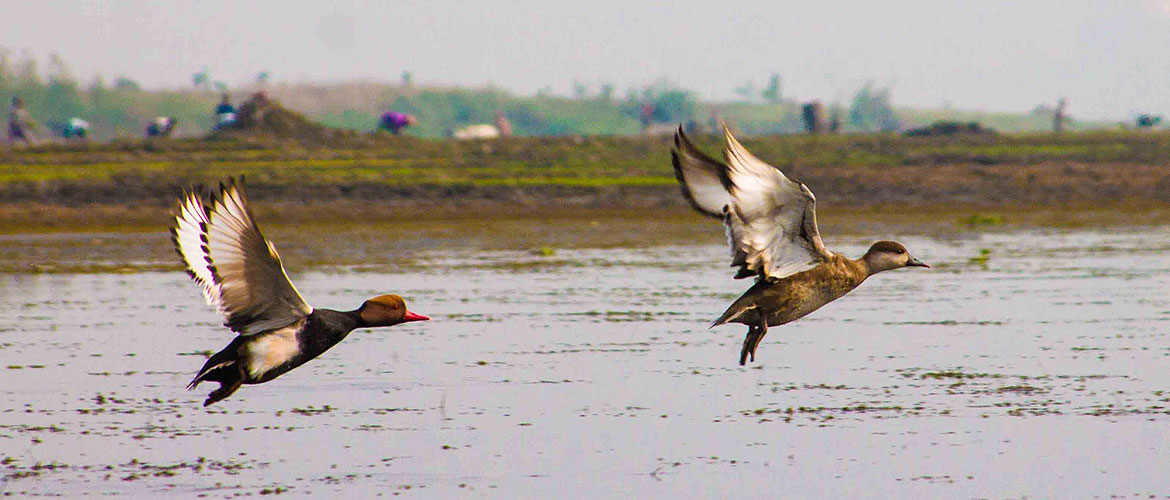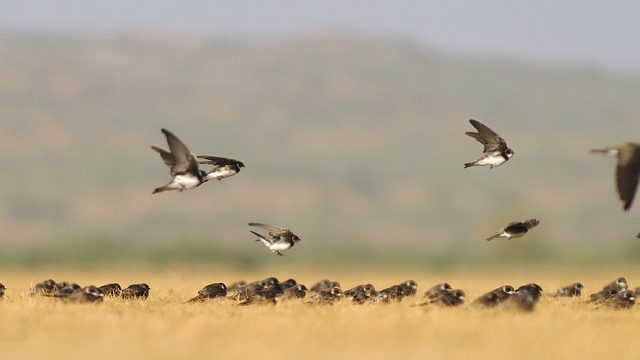The first long weekend of 2017 is here! And that means short getaways to enjoy the last

West Bengal: Purbasthali
Don’t let the early morning mist deter you. Set sail in a country boat and by the time the mist lifts, you will see a huge variety of birds already up and about. Chupir Char, an ox-bow lake about 150km from Kolkata is home to a large number of resident and migratory birds, including lesser whistling teals, red-crested pochards, little grebe and many more. Located in Purbasthali in the Burdwan district of West Bengal, the waterbody was formed when the Bhagirathi (the local name for the Ganga) changed its course. A local organisation Kasthashali Banbithi looks after the birds and offer guided tours to visitors for a fee. Best time to visit: December-January.
Getting There: Either take a Katwa-bound local train from Howrah or Sealdah to Purbasthali station, which takes less than three hours. From the station, there are battery-operated rickshaws (locally called ‘toto’s) that will take you to the birding site. By road, you can either follow NH-34 to Krishnanagar and then travel via Nabadwip to Parulia or take NH-2 to Parulia via Memari and Satgachhia. The first route is around 135km and the second around 145km.
Where To Stay: A small three-room basic lodge, run by Kasthashali Banbithi (tel: 95646 42694; Rs 400 per head), is the only place to stay. Krishnanagar, less that two hours’ drive away, has more options. You could try Hotel Haveli (from Rs1,800 plus taxes doubles; havelihotel.com).

Maharashtra: Bhigwan
Located in the sugarcane heartland of Maharashtra is Bhigwan, the backwaters of the Ujani Dam on the Bhima River. About 250km from Mumbai and 100 km from Pune, it is one of the best places to see the greater flamingos up close in winter. In the cold months, the bird species found here increases manifold with migratory birds joining the resident varieties. At Diksal, a narrow road runs through the lake and is a good place to watch birds. But if you head to Kumbhargaon, located at another part of the lake, you can have a peacefully long ride, drawing close to the flocks of birds. At both places, local fishermen offer boat rides for birding. Best time to visit: December to February. You may combine a visit to Mayureshwar Wildlife Sanctuary, known for blackbucks, while visiting Bhigwan.
Getting There: It is best to drive down to Bhigwan from Pune or Mumbai. The Solapur-bound ST buses from Pune are best avoided unless you want to keep the costs low. Diksal is about 8km from Bhigwan village. Kumbhargaon is at the end of a service road off the Pune-Solapur Road.
Where To Stay: Baramati, an industrial town, about 25km from Bhigwan, is the best place to stay in terms of good hotels. There are several good hotels, such as Krishnasagar Residency (from Rs2,400 doubles; krishnasagarhotel.com) and Hotel Surya Baramati (from Rs2,500; hotelsuryabaramati.com). If you want stay near the birding spot, then the simple home stay run by Sandeep Nagare (tel: +91-8975-017405, +91-99606-10615) is the best option. He can also arrange for boats and is an excellent guide. Thane-based Vihang Travels (tel: +91-98921-38338/+91-98693-04053) operates birding and photography trips to Bhigwan.

Maharashtra: Sewri
Oblivious of the noise from ship repairing, unaware of the pollution and garbage around them, pink-feathered flamingos in the hundreds, intently scour the marshy land for food. To the uninitiated, Sewri, on the eastern part of south Mumbai, is a surprise indeed. It is said that the birds fly in from the Rann of Kutch in Gujarat every winter to the Sewri mudflats, now dubbed as Flamingo Point. The flamingos usually start arriving in November and stay on till March. The regulars know that the best time to see the flamingos up close is four hours before or after the high tide. Broad-billed sandpipers, curlew sandpipers, black-tailed godwits, whimbrels, and Eurasian curlews are also seen during winter. Best time to visit: December to February.
Getting There: Sewri railway station, on the Harbour Line of the Central Railway’s suburban line is about 20 minutes’ walk from the birding point. Or you can drive straight to the Sewri jetty. Mumbai-based BNHS-India holds ‘flamingo watch’ programmes on most weekends from December to February (Rs200 per head for non-members; bnhs.org)
Where To Stay: No matter where you stay in Mumbai, it is easiest to get your bearings by the suburban railway route. If you are travelling by train, it is convenient to catch a Harbour Line train from CST and Navi Mumbai. For those travelling by the Central Railway suburban line, can change trains at Kurla station.

Gujarat: Thol Bird Sanctuary
A mere 20km from Ahmedabad city is the Thol Bird Sanctuary, home to more than 100 species of birds, including pelicans, egrets, herons, spoonbills, ducks and whistling teals. It is said that the reservoir was built by Baroda’s Maharaja Sayajirao Gaikwad in 1912 and the lake, surrounded by light forest, was declared a sanctuary in 1988. Open daily from 6am to 6pm, it’s ideal for a family outing. Although there is a motorable road around the sanctuary, it is advisable to take the walking path, which gives a better view of the lake. Best time to visit: December to February.
Getting There: It is about an hour’s drive from Ahmedabad. The bird sanctuary is situated away from the Thol village.
Where To Stay: There is no place to stay near the sanctuary, so Ahmedabad is your best bet. gujarattourism.com.

Kerala: Kadalundi Bird Sanctuary
The mixed terrain of Kadalundi Bird Sanctuary, about 20km from Kozhikode, allows nearly a hundred species of birds to call it home. Add to this another 60 odd species of migratory birds that visit in winter, and it is no wonder that Kadalundi is a birders’ delight. The sanctuary is situated at the point where the Kadalundi river joins the Arabian Sea and is marked by mangrove forests and a cluster of islands. Catch a panoramic view of the area from the 200m-high hillock that overlooks the sanctuary. If you are lucky, you may catch sight of otters and jackals among the mangroves. Best time to visit: November to March.
Getting There: Drive down from Kozhikode, about 20km away.
Where To Stay: There is no place to stay around the sanctuary. Kozhikode is the nearest option. keralatourism.org
Birding
Gujarat
Kadalundi Bird Sanctuary



